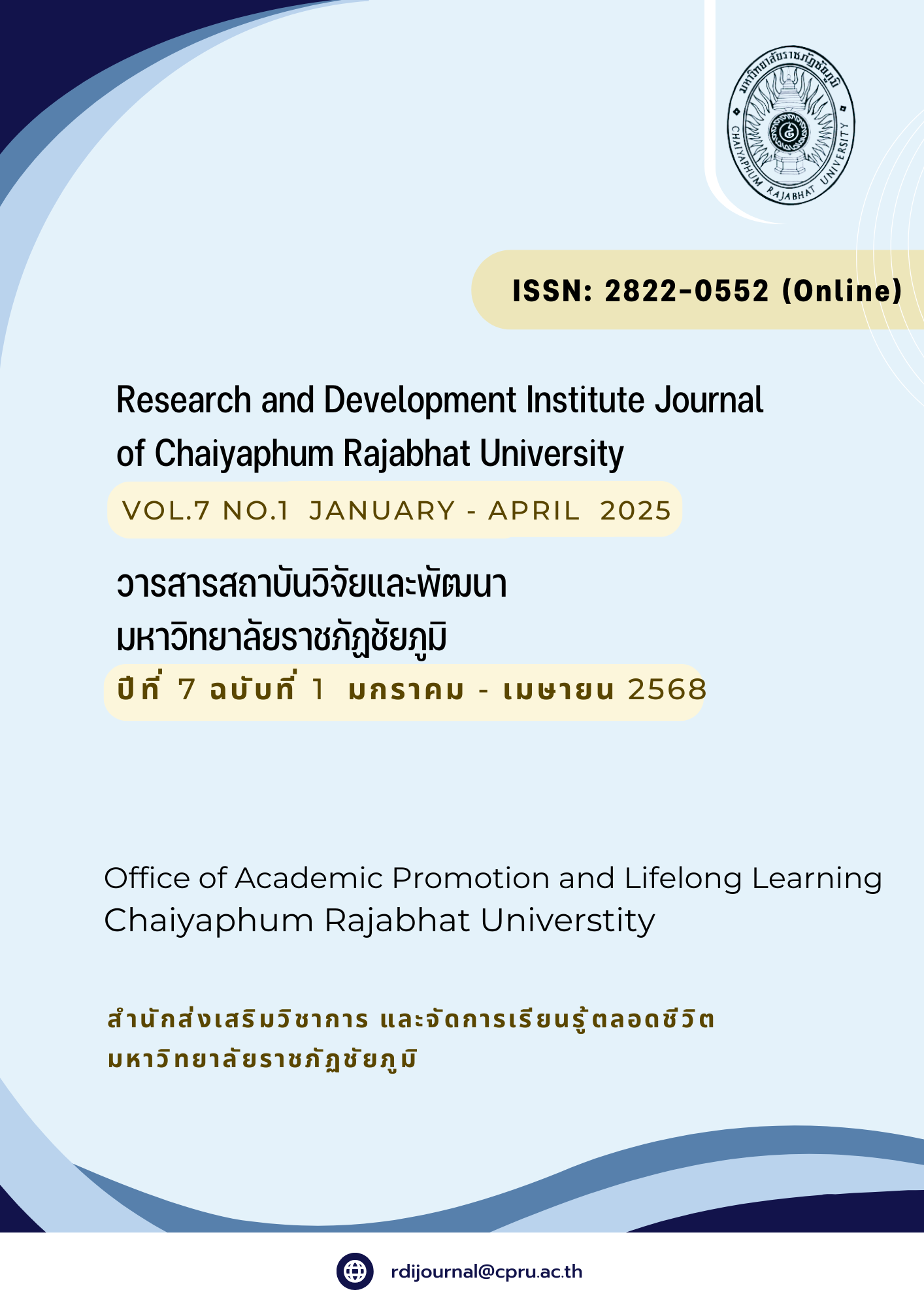พฤติกรรมการฟังภาษาอังกฤษที่ส่งผลต่อทักษะการฟังภาษาอังกฤษของนักเรียนชั้นมัธยมศึกษาตอนปลาย
Main Article Content
บทคัดย่อ
การวิจัยครั้งนี้มีวัตถุประสงค์เพื่อ 1) ศึกษาพฤติกรรมการฟังภาษาอังกฤษ 2) ศึกษาทักษะการฟังภาษาอังกฤษ 3) ศึกษาความสัมพันธ์ของพฤติกรรมการฟังภาษาอังกฤษกับทักษะการฟังภาษาอังกฤษ และ 4) ศึกษาอิทธิพลของพฤติกรรมการฟังภาษาอังกฤษที่ส่งผลต่อทักษะการฟังภาษาอังกฤษของนักเรียนชั้นมัธยมศึกษาตอนปลาย กลุ่มตัวอย่าง ได้แก่ นักเรียนชั้นมัธยมศึกษาตอนปลาย ภาคเรียนที่ 2 ปีการศึกษา 2566 โรงเรียนราชประชานุเคราะห์ 54 จังหวัด อำนาจเจริญ จำนวน 110 คน ด้วยวิธีการสุ่มอย่างง่าย เครื่องมือที่ใช้ในการวิจัย ได้แก่ แบบทดสอบทักษะการฟังภาษาอังกฤษ และแบบสอบถามพฤติกรรมการฟังภาษาอังกฤษ สถิติที่ใช้ในการวิเคราะห์ข้อมูลประกอบด้วย ค่าฉลี่ย ส่วนเบี่ยงเบนมาตรฐาน ร้อยละ สัมประสิทธิ์สหสัมพันธ์เพียรสัน และการวิเคราะห์ถดถอยอย่างง่าย
ผลการวิจัยพบว่า
- นักเรียนชั้นมัธยมศึกษาตอนปลาย โรงเรียนราชประชานุเคราะห์ 54 จังหวัดอำนาจเจริญ มีพฤติกรรมการฟังภาษาอังกฤษเฉลี่ยโดยรวมอยู่ในระดับมาก (= 3.90, S.D. = 0.34)
- นักเรียนชั้นมัธยมศึกษาตอนปลาย โรงเรียนราชประชานุเคราะห์ 54 จังหวัดอำนาจเจริญ มีคะแนนเฉลี่ยทักษะการฟังภาษาอังกฤษคิดเป็นร้อยละ 71.08 (= 8.53 , S.D. = 1.86)
- พฤติกรรมการฟังภาษาอังกฤษกับทักษะการฟังภาษาอังกฤษ มีค่าสหสัมพันธ์เพียรสันอยู่ที่ 0.80 มีความสัมพันธ์กันในทางบวกที่ระดับนัยสำคัญทางสถิติ 0.01
- ผลของการวิเคราะห์การถดถอยอย่างง่ายแสดงให้เห็นว่าพฤติกรรมการฟังภาษาอังกฤษสามารถทำนายทักษะการฟังภาษาอังกฤษได้อย่างมีนัยสำคัญ (β = 0.80, p < 0.01) โดยอธิบายความแปรปรวนของทักษะการฟังได้ 64% (R² = 0.64) สมการการถดถอยที่ได้จากการวิเคราะห์คือ: คะแนนการฟัง = -8.35 + 4.32 × พฤติกรรมการฟัง
Article Details

This work is licensed under a Creative Commons Attribution-NonCommercial-NoDerivatives 4.0 International License.
การอนุญาตให้ใช้ข้อความ เนื้อหา รูปภาพ ฯลฯ ของสิ่งพิมพ์ ผู้ใช้รายใดก็ตามที่จะอ่าน ดาวน์โหลด คัดลอก แจกจ่าย พิมพ์ ค้นหา หรือเชื่อมโยงไปยังข้อความทั้งหมดของบทความ รวบรวมข้อมูลสำหรับการจัดทำดัชนี ส่งต่อเป็นข้อมูลไปยังซอฟต์แวร์ หรือใช้เพื่อวัตถุประสงค์ทางกฎหมายอื่นใด แต่ห้ามนำไปใช้ในเชิงพาณิชย์หรือมีเจตนาเอื้อประโยชน์ทางธุรกิจใดๆ เผยแพร่ภายใต้สัญญาอนุญาตครีเอทีฟคอมมอนส์แบบแสดงที่มา-ไม่ใช้เพื่อการค้า (Creative Commons Attribution-NonCommercial-NoDerivatives 4.0 International License)

This work is licensed under a Creative Commons Attribution-NonCommercial-NoDerivatives 4.0 International License
References
Al-Tuwairesh, N. S. (2013). Expertise in L2 listening: Metacognitive instruction and deliberate practice in a Saudi university context [Doctoral dissertation, University of Leeds]. White Rose eTheses Online. https://etheses.whiterose.ac.uk/id/eprint/5418/
Bekleyen, N. (2009). Helping Teachers Become Better English Students: Causes, Effects, and Coping Strategies for Foreign Language Listening Anxiety. System, 37(4), 664-675.
Bodie, G. D. (2012). Listening as positive communication. In T. Socha & M. Pitts (Eds.), The positive side of interpersonal communication (pp. 109-125). Peter Lang.
Bodie, G. D., Worthington, D. L., & Gearhart, C. C. (2012). The listening styles profile-revised (LSP-R): A scale revision and evidence for construct validity. Communication Quarterly, 60(1), 72–90. https://doi.org/10.1080/01463373.2012.720343
Bodie, G. D., Vickery, A. J., Cannava, K., & Jones, S. M. (2015). The role of “active listening” in informal helping conversations: Impact on perceptions of listener helpfulness, sensitivity, and supportiveness and discloser emotional improvement. Western Journal of Communication, 79(2), 151-173. https://doi.org/10.1080/10570314.2014.943429
Brownell, J. (2012). Listening: Attitudes, principles, and skills (5th ed.). Pearson Education.
Chantapidta, C. (2012). Development of supplementary communicative English listening exercises for Mathayomsuksa four students, Bualuangwitthayakhom School, Buriram [Master thesis, Silpakorn University]. [in Thai]
Field, J. (2008). Listening in the language classroom. Cambridge University Press.
Foley, B. H. (1994). Listen to me! Beginning listening, speaking & pronunciation. Heinle & Heinle.
Graham, S. (2006). Listening comprehension: The learners’ perspective. System, 34(2), 165–182. https://doi.org/10.1016/j.system.2005.11.001
Graham, S. (2011). Self-efficacy and academic listening. Journal of English for Academic Purposes, 10(2), 113–117. https://doi.org/10.1016/j.jeap.2011.04.001
Goh, C. C. M. (2000). A cognitive perspective on language learners’ listening comprehension problems. System, 28(1), 55–75. https://doi.org/10.1016/S0346-251X(99)00060-3
Imhof, M., & Janusik, L. A. (2006). Development and validation of the Imhof-Janusik Listening Concepts Inventory to measure listening conceptualization differences between cultures. Journal of Intercultural Communication Research, 35(2), 79-98. https://doi.org/10.1080/17475750600909246
Janusik, L. A., & Wolvin, A. D. (2009). 24 hours in a day: A listening update to the time studies. International Journal of Listening, 23(2), 104-120. https://doi.org/10.1080/10904010903014442
Lindeman, R. H., Merenda, P. F., & Gold, R. Z. (1980). Introduction to Bivariate and Multivariate Analysis. Scott Foresman and Company.
Nurjanah, N., Miranti, I., & Dwiastuty, N. (2018). The Correlation Between Students’ Habit In Listening to Songs and Students’ English Listening Skill. DEIKSIS, 10(1), 43-48. http://dx.doi.org/10.30998/deiksis.v10i01.2125
Pamungkas, I. B. A., & Adi, S. S. (2020). Students' perception about improving English listening skills using movies among the vocational high school students. Erudio Journal of Educational Innovation, 7(2), 128-138.
Rasskazova, T., & Glukhanyuk, N. (2018). Factors affecting listening in L2 learning. INTED2018 Proceedings of 12th International Technology, Education and Development Conference, 656-662. https://doi.org/10.21125/inted.2018.1117
Rost, M. (2016). Teaching and researching listening (3rd ed.). Routledge.
Takeno, J., & Takatsuka, S. (2007). Factors affecting listening comprehension ability of Japanese learners of English. Okayama University Digital Information Repository.
Thuong, L., & Tham, D. (2023). Students’ Attitudes Towards Using Mobile Applications in Learning English Listening Skills at Ho Chi Minh City University of Foreign Languages and Information Technology. VNU Journal of Science: Education Research, 39(2). https://doi.org/10.25073/2588-1159/vnuer.4703
Vandergrift, L. (2004). Listening to learn or learning to listen. Annual Review of Applied Linguistics, 24, 3-25. https://doi.org/10.1017/S0267190504000017
Vandergrift, L., & Baker, S. (2015). Learner variables in second language listening comprehension: An exploratory path analysis. Language Learnin, 65(2), 390-416. https://doi.org/10.1111/lang.12105
Vandergrift, L., & Goh, C. C. M. (2012). Teaching and Learning Second Language Listening: Metacognition in Action. Routledge.
Ward, J. (2018). Exploring L2 listening instruction: Theory and practice in a tertiary context [Doctoral dissertation, University of Birmingham].
Weger Jr., H., Castle Bell, G., Minei, E. M., & Robinson, M. C. (2014). The relative effectiveness of active listening in initial interactions. International Journal of Listening, 28(1), 13–31. https://doi.org/10.1080/10904018.2013.813234

